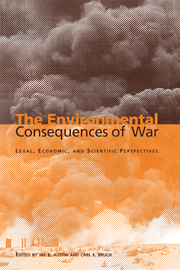Book contents
- Frontmatter
- Contents
- List of illustrations
- List of tables
- List of contributors
- Acknowledgements
- Foreword by Klaus Toepfer
- Introduction
- Part I General principles
- Part II The legal framework
- Part III Assessing the impacts – scientific methods and issues
- Introduction
- 11 Scientific assessment of the long-term environmental consequences of war
- 12 The Gulf War impact on the terrestrial environment of Kuwait: an overview
- 13 War-related damage to the marine environment in the ROPME Sea Area
- 14 War and biodiversity: an assessment of impacts
- Introduction
- 15 Tracking the four horsemen: the public health approach to the impact of war and war-induced environmental destruction in the twentieth century
- 16 Defoliants: the long-term health implications
- 17 The impact of military preparedness and militarism on health and the environment
- 18 War and infectious diseases: international law and the public health consequences of armed conflict
- Part IV Valuing the impacts – economic methods and issues
- Part V Prospects for the future
- Index
18 - War and infectious diseases: international law and the public health consequences of armed conflict
Published online by Cambridge University Press: 04 August 2010
- Frontmatter
- Contents
- List of illustrations
- List of tables
- List of contributors
- Acknowledgements
- Foreword by Klaus Toepfer
- Introduction
- Part I General principles
- Part II The legal framework
- Part III Assessing the impacts – scientific methods and issues
- Introduction
- 11 Scientific assessment of the long-term environmental consequences of war
- 12 The Gulf War impact on the terrestrial environment of Kuwait: an overview
- 13 War-related damage to the marine environment in the ROPME Sea Area
- 14 War and biodiversity: an assessment of impacts
- Introduction
- 15 Tracking the four horsemen: the public health approach to the impact of war and war-induced environmental destruction in the twentieth century
- 16 Defoliants: the long-term health implications
- 17 The impact of military preparedness and militarism on health and the environment
- 18 War and infectious diseases: international law and the public health consequences of armed conflict
- Part IV Valuing the impacts – economic methods and issues
- Part V Prospects for the future
- Index
Summary
Introduction: war as disruption of the human-microbe environment
Much attention has rightly been concentrated on the adverse ecological consequences produced by wartime destruction of the natural environment. Iraq's deliberate attacks on Kuwaiti oil installations serve as dramatic examples of such environmental damage. When we contemplate the environmental consequences of war, we should also be concerned about war-induced disruptions to environmental contexts that encompass more than damage to natural ecosystems. The environmental context that forms the backdrop for this chapter is the complex relationship between humans and pathogenic microbes. One of the most devastating environmental consequences of war is the disruption of the peacetime human-microbe relationship, which produces outbreaks and epidemics of infectious diseases.
Both historical and more recent events prove that armed conflict produces opportunities for pathogenic microbes to spread in human populations. Experts often cite war as a factor contributing to the re-emergence of infectious diseases as a public health problem in the last twenty to thirty years. While warfare clearly plays a role in the current global crisis of emerging infectious diseases, it has always been a situation of microbial opportunity.
The human and microbial world have been interacting since the development of Homo sapiens. The long history of human-microbe interaction is punctuated by changes in the relationship that have allowed microbes or humans the opportunity to gain an upper hand. Recent analysis of the global problem of emerging infectious diseases provides a window on the many different kinds of changes that disrupt the human-microbe environment: population growth, urbanization, migration, climatic events, sexual behavior, technological and scientific advances, and war.
- Type
- Chapter
- Information
- The Environmental Consequences of WarLegal, Economic, and Scientific Perspectives, pp. 444 - 466Publisher: Cambridge University PressPrint publication year: 2000
- 2
- Cited by



